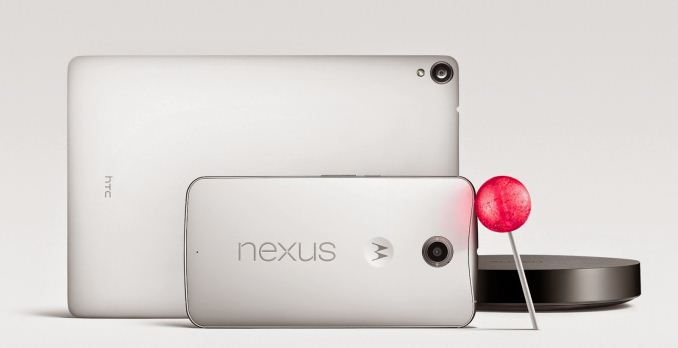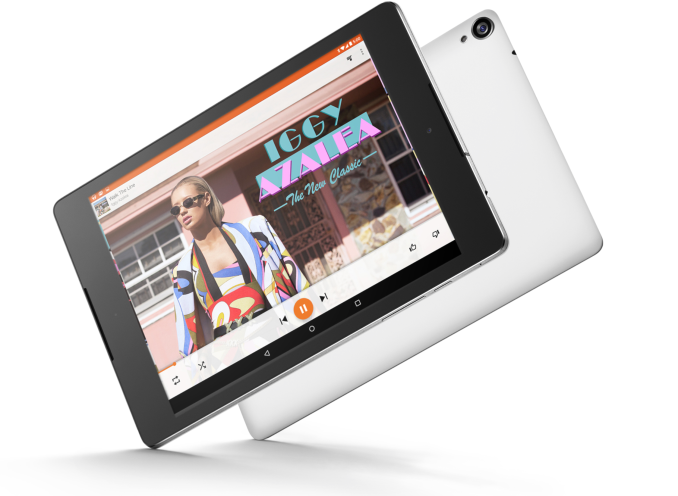Google Announces the Nexus 6 and Nexus 9 Running Android Lollipop
by Brandon Chester on October 15, 2014 12:33 PM EST
Today Google has officially announced the newest devices in the Nexus line, just one day before Apple's October event. Both devices have been rumored for some time now, and this is the first time in a while that we've seen Google introduce a new smartphone and tablet at the same time. The first device in the announcement is the Nexus 6, made by Motorola. The second is the Nexus 9 tablet made by HTC. To give an overview of how both devices look on paper, I've put together their specifications in a chart below.
| Nexus 6 | Nexus 9 | |
| SoC | 2.7GHz Snapdragon 805 (APQ8084) with 4 x Krait 450 + Adreno 420 at 600MHz | 2.3GHz 64-bit dual core Tegra K1 Denver SoC |
| RAM/NAND | 3GB LPDDR3 + 32/64GB NAND | 2GB LPDDR3 + 16/32GB NAND |
| Display | 5.96" 2560x1440 AMOLED | 8.9" 2048x1536 IPS LCD |
| Network | 2G / 3G / 4G LTE | WiFi only or 2G / 3G / 4G LTE SKU |
| Dimensions | 82.98 x 159.26 x 10.06mm, 184g | 153.68 x 228.25 x 7.95mm, 425g WiFi, 436g LTE |
| Camera | 13MP Rear Facing with F/2.0 aperture and OIS, 2MP FFC 4K video recording |
8MP Rear Facing with F/2.4 aperture, 1.6MP FFC |
| Battery | 3220 mAh (12.236 Whr) | 6700 mAh (25.46 Whr) |
| OS | Android 5.0 Lollipop | Android 5.0 Lollipop |
| Connectivity | 802.11a/b/g/n/ac + BT 4.1, USB2.0, GPS/GNSS, NFC | 802.11a/b/g/n/ac + BT 4.1, USB2.0, GPS/GNSS, NFC |
| SIM Size | NanoSIM | NanoSIM on LTE SKU |
 The Nexus 6 features a similar appearance to Motorola's other devices like the Moto X and Moto G. The plastic back is surrounded by a contoured aluminum frame that curves downward at the top where the 3.5mm headphone jack is located. On the back is Google's traditional Nexus logo, accompanied by an indented motorola logo and a centered rear-facing camera. The front is dominated by a large 5.96" display with a pixel density of 493ppi, and stereo speakers on the top and bottom bezels.
The Nexus 6 features a similar appearance to Motorola's other devices like the Moto X and Moto G. The plastic back is surrounded by a contoured aluminum frame that curves downward at the top where the 3.5mm headphone jack is located. On the back is Google's traditional Nexus logo, accompanied by an indented motorola logo and a centered rear-facing camera. The front is dominated by a large 5.96" display with a pixel density of 493ppi, and stereo speakers on the top and bottom bezels.
In terms of its specifications, the Nexus 6 is competitive with all the current Android flagship devices. It packs Qualcomm's latest silicon, a hefty battery, and a high resolution display. However, those premium specs are accompanied by a premium price of $649 outright which is significantly more than the $349 that the Nexus 5 is priced at. The Nexus 5 has been given a new web page along with the other Nexus devices which suggests it isn't going disappear with the launch of this newer, more expensive smartphone.
The next announcement was the Nexus 9 made by HTC. This is the first tablet from HTC since the days of Android Gingerbread and Honeycomb where HTC announced they were exiting the tablet market. With its soft touch back, the Nexus 9 is similar in its design to the Nexus 5. Unlike the Nexus 5 which was an entirely plastic construction, the sides of the Nexus 9 are made of brushed metal.
The front of the device is similar to the Nexus 7 with its asymmetrical bezels. The shape of the device is a departure from any tablet Google has produced before, with a 2048x1536 4:3 display like Apple's iPad. Both the 8.9" display size and 4:3 aspect ratio make the Nexus 9 a significantly larger device than the Nexus 7.
The SoC is the biggest point of interest with the Nexus 9. It will be the first device to ship with Nvidia's Project Denver architecture. This is a custom 64-bit ARMv8 architecture designed by Nvidia, a significant departure from the standard ARM cores used in previous Tegra chips. We covered the details about Tegra K1 Denver previously and you can read that over to get a more in-depth look at NVIDIA's new chip.
Along with the new device announcements comes the official name for the next version of Android. Android L is now Android 5.0 Lollipop, and it will ship on the new Nexus 6 and Nexus 9. Lollipop comes with Google's new Material Design and Google's new ART runtime, and will be rolling out to existing compatible Nexus and Google Play Edition devices in the coming weeks.
The Nexus 9 will be available for pre-order on October 17th starting at $399 for 16GB, while the Nexus 6 will be available sometime in late October at $649 for 32GB.
Source: Google Blog











148 Comments
View All Comments
evilspoons - Wednesday, October 15, 2014 - link
The SoC is not the problem in the 2012 N7... the flash memory is just horrible. I installed a F2FS ROM on mine and the thing is like 80% faster, but there are times where it still stalls horribly. My custom kernel allows overclocking and I played with that a bit and it made no difference whatsoever - the processor is almost always waiting for the flash memory to catch up.ShieTar - Thursday, October 16, 2014 - link
Weird. I got a Samsung tablet, never bothered to update the android on it (4.1.2) and still can use it for absolutely everything offered in the app-store, not just as an e-reader. What exactly do you suspect to not run on it?My only real problem with it is weight, its 340g for the 8" model, and that can get uncomfortable after an hour or two. Sadly, nobody seems interested in developing a real light-weight tablet.
RDS - Wednesday, October 22, 2014 - link
Your use case should determine your tablet need.The value of Nexus lies in having a Device that you can completely manage as opposed to one that is controlled / managed by a service provider or content provider. Does your ISP manage your home PC for you :).
OS Upgrades / Rollbacks are trivial on a Nexus Device much simpler to manage than on a OEM Tablet vendor offering.
You can manage your nexus phone and tablet with a single app.
The current shortcomings of the Nexus 9 in my humble opinion are:
1) Lack of a Flash Memory Card port. (Probably Intentional to not compete too closely with the Android Tablet Makers Product Offerings)
2) Lack of an HDMI video out port.
3) USB Port is 2.0 (NBD Really)
edtoml - Saturday, November 1, 2014 - link
4) Lack of wireless charging. Its surprisingly handy on my nexus 7 LTE.5) Land of storage. 32G should be a minimum NOT a maximum for a high end tablet
6) Price increment between 16G, 32G and LTE. Think someone's margins get much better with LTE (and 32G)
tuxRoller - Wednesday, October 15, 2014 - link
Yes, it will, apparently.http://www.androidcentral.com/yes-even-2012-nexus-...
Calabros - Wednesday, October 15, 2014 - link
That 4:3 ratio is an official admission that Apple was dead right :-)Smultie - Wednesday, October 15, 2014 - link
Yeah, just as Apple's 5.5 inch phone is an admission that Android was dead right. ;-)danbob999 - Wednesday, October 15, 2014 - link
Also new iPhones are 16:9. The iPad still has a legacy 4:3 for historic reasons. If the first iPad was released today, it would be widescreen. It's a shame that Google copied the old iPad aspect ratio.Wolfpup - Wednesday, October 15, 2014 - link
Seems like 4:3 fits printed content better...Wolfpup - Wednesday, October 15, 2014 - link
EDIT: Also, it makes both orientations work better IMO.